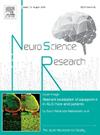A systematic study of changes in monoamine neurotransmitters in the rat brain following acute administration of alpha-methyltryptamine (AMT), 5-methoxy-alpha-methyltryptamine (5-MeO-AMT) and 5-methoxy-N,N-diisopropyltryptamine (5-MeO-DiPT)
IF 2.3
4区 医学
Q3 NEUROSCIENCES
引用次数: 0
Abstract
Alpha-methyltryptamine (AMT), 5-methoxy-alpha-methyltryptamine (5-MeO-AMT), and 5-methoxy-N,N-diisopropyltryptamine (5-MeO-DiPT) are three synthetic tryptamines with hallucinogenic properties that are widely abused worldwide. The hallucinogenic effects of tryptamines are primarily related to activation of the 5-HT receptor, and among the many subtypes of 5-HT receptors, the 5-HT2A receptor is the key receptor for hallucinogenic effects. In the present study, the monoamine neurotransmitters DA and its metabolites 3,4-Dihydroxyphenylacetic Acid (DOPAC) and homovanillic acid (HVA), 5-HT and its metabolite 5-hydroxyindoleacetic acid (5-HIAA) were systematically investigated in the prefrontal cortex (PFC), nucleus accumbent (NAc), dorsolateral striatum (DLS) and hippocampus (HIP) using a validated HPLC-ECD analytical method after administration of the three tryptamines at different doses. The results showed that the three tryptamines had certain effects and the effects were different in different brain regions and showed that AMT, 5-MeO-AMT and 5-MeO-DiPT had significant effects on monoaminergic neurotransmitters in rat brains. Among them, DAergic and serotonergic play important roles, and this study provides valuable information for further research on the neurochemical effects of tryptamine hallucinogens in the brain.
急性给药α -甲基色胺(AMT)、5-甲氧基- α -甲基色胺(5-MeO-AMT)和5-甲氧基- n, n -二异丙基色胺(5-MeO-DiPT)后大鼠脑内单胺类神经递质变化的系统研究
α -甲基色胺(AMT)、5-甲氧基- α -甲基色胺(5-MeO-AMT)和5-甲氧基- n, n -二异丙基色胺(5-MeO-DiPT)是三种具有致幻作用的合成色胺,在世界范围内被广泛滥用。色胺的致幻作用主要与5-HT受体的激活有关,在5-HT受体的众多亚型中,5-HT2A受体是致幻作用的关键受体。本研究采用经验证的HPLC-ECD分析方法,系统研究了不同剂量给药后,单胺类神经递质DA及其代谢物3,4-二羟基苯基乙酸(DOPAC)和同型香草酸(HVA), 5-HT及其代谢物5-羟基吲哚乙酸(5-HIAA)在前额叶皮质(PFC)、伏隔核(NAc)、背外侧纹状体(DLS)和海马(HIP)中的含量。结果表明,三种色胺均有一定作用,且在不同脑区作用不同,表明AMT、5-MeO-AMT和5-MeO-DiPT对大鼠脑内单胺类神经递质有显著影响。其中DAergic和5 -羟色胺能发挥着重要作用,本研究为进一步研究色胺类致幻剂在脑内的神经化学作用提供了有价值的信息。
本文章由计算机程序翻译,如有差异,请以英文原文为准。
求助全文
约1分钟内获得全文
求助全文
来源期刊

Neuroscience Research
医学-神经科学
CiteScore
5.60
自引率
3.40%
发文量
136
审稿时长
28 days
期刊介绍:
The international journal publishing original full-length research articles, short communications, technical notes, and reviews on all aspects of neuroscience
Neuroscience Research is an international journal for high quality articles in all branches of neuroscience, from the molecular to the behavioral levels. The journal is published in collaboration with the Japan Neuroscience Society and is open to all contributors in the world.
 求助内容:
求助内容: 应助结果提醒方式:
应助结果提醒方式:


